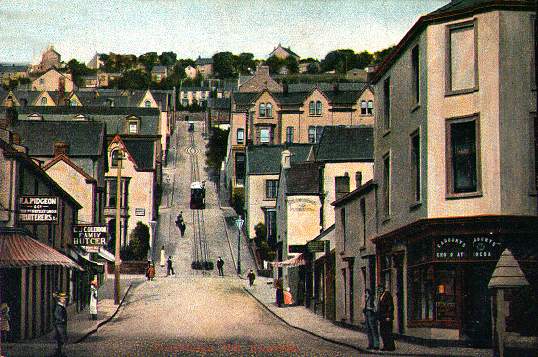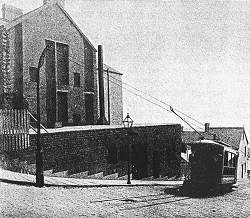

The view on this postcard, published by Frederick Hartmann (series no. 2715.11) and printed in Germany, originates in 1899 (it appeared in an article in Tramway & Railway World in that year) although the card itself would have been issued in 1904, long after the tramway shown had ceased operation. It may have only a small image of a tramcar, but in fact shows a complete tramway! The view is extremely rare and there are few pictures of any kind showing this small and short lived line.
Under an order of 1896 this line was promoted by the Swansea Constitution Hill Incline Tramway Co. Ltd, using as consulting engineer George Croydon Marks, who was also involved with the cable tramway in Matlock and the Lynton and Lynmouth Cliff Railway. Its purpose was to serve the new housing of the Town Hill Estate being built on Mount Pleasant, above the port of Swansea. Running on Constitution Hill, the lower terminus was at St. George Street (now Hannover Street) and the upper was at Terrace Road. Completed in early 1898 by contractors George Webb and Company of Westminster, it failed its first Board of Trade inspection on safety grounds, but after remedial work opened for service on 27th August 1898, although early technical problems caused it to close and re-open a week later. The service was largely continuous from 11 a.m. to 11.15 p.m., taking about two and a half minutes for each journey. There was a flat fare of one penny (up or down).
The system used two counterbalanced cars, permanently fixed funicular style to a 3.5" circumference steel cable, carried and guided by pulleys in a conduit. The cable was attached to the cars by forged steel anchor plates. The track was thought to be to 3 ft 6 in gauge, was interlaced with a 135 ft. long passing loop at Montpellier Terrace in the middle and was just 14 chains (308 yards) in length. The points at the loop were automatic, being moved over by each car ready for its return journey.
 At the top of the hill was a winding house (photo left). It contained two Tangye gas engines, rated at 13 and 16 brake horsepower, one being used while the other was kept for breakdowns. The engines were connected to a line shaft which in turn operated a large crown wheel. This engaged with the driving pulley, which was below the road surface at the end of the line. The cable was guided into the conduit by two rollers, one of which operated an indicator to show the engine driver the relative position and motion of the cars. Starting and reversing were controlled by friction clutches supplied by D. Bridge and Company of Salford.
At the top of the hill was a winding house (photo left). It contained two Tangye gas engines, rated at 13 and 16 brake horsepower, one being used while the other was kept for breakdowns. The engines were connected to a line shaft which in turn operated a large crown wheel. This engaged with the driving pulley, which was below the road surface at the end of the line. The cable was guided into the conduit by two rollers, one of which operated an indicator to show the engine driver the relative position and motion of the cars. Starting and reversing were controlled by friction clutches supplied by D. Bridge and Company of Salford.
The trams were built by the Brush Electrical Engineering Company at Loughborough and seated 18 people on reversible seats that were mounted at an angle to compensate for the slope of the car when in service on the average 1 in 5 gradient of the hill (maximum 1 in 3.5), rising a total of 185 ft. The cars had powerful "Scotch" brakes on the four wheels and an emergency brake which clamped onto the centre slot rails (tested by the Board of Trade by stopping a run away car loaded with 2.5 tons of iron!). Trolley poles offset to one side of each car connected to the overhead wire for signalling purposes, with bells powered by batteries carried on the cars, and sounding on both the cars and in the winding house. (For car close up see Historic Photos).
The line was not a success due to low receipts and the high running costs of two crew on each tram plus the winding house staff. The line closed for traffic in early 1902 and in 1903 was offered for sale as a whole, but had no takers. The track was then taken up, the assets were sold and the company was wound up in 1905.
![]() Go to Postcard Of The Month Index
Go to Postcard Of The Month Index